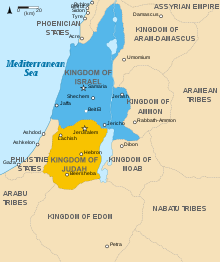
Back Geskiedenis van antieke Israel en Juda Afrikaans Geschichte Israels ALS تاريخ مملكتي إسرائيل ويهوذا القديمتين Arabic Historia del Israel antiguu AST Боронғо Израиль һәм Йәһүдиә тарихы Bashkir Història de l'antic Israel Catalan Starověké dějiny Židů Czech Oldtidens Israels og Judæas historie Danish Geschichte Israels German Historio de Antikva Israelo Esperanto

| History of Israel |
|---|
 |
|
|
| Part of a series on |
| Jews and Judaism |
|---|
The history of ancient Israel and Judah spans from the early appearance of the Israelites in Canaan's hill country during the late second millenium BCE, to the establishment and subsequent downfall of the two Israelite kingdoms in the mid-first millenium BCE. This history unfolds within the Southern Levant during the Iron Age. The earliest documented mention of "Israel" as a people appears on the Merneptah Stele, an ancient Egyptian inscription dating back to around 1208 BCE. Archaeological evidence suggests that ancient Israelite culture evolved from the pre-existing Canaanite civilization. During the Iron Age II period, two Israelite kingdoms emerged in the region: the Kingdom of Israel in the north and the Kingdom of Judah in the south.
According to the Hebrew Bible, a "United Monarchy" consisting of Israel and Judah existed as early as the 11th century BCE, under the reigns of Saul, David, and Solomon; the country later split into two kingdoms: Israel, containing the cities of Shechem and Samaria in the north, and Judah (containing Jerusalem and the Jewish Temple) in the south. The historicity of the United Monarchy is debated—as there are no archaeological remains of it that are accepted as consensus—but historians and archaeologists agree that Israel and Judah existed as separate kingdoms by c. 900 BCE[1]: 169–195 [2] and c. 850 BCE,[3] respectively.[4]
The Kingdom of Israel was destroyed around 720 BCE, when it was conquered by the Neo-Assyrian Empire.[5] While the Kingdom of Judah remained intact during this time, it became a client state of first the Neo-Assyrian Empire and then the Neo-Babylonian Empire. However, Jewish revolts against the Babylonians led to the destruction of Judah in 586 BCE, under the rule of Babylonian king Nebuchadnezzar II. According to the biblical account, the armies of Nebuchadnezzar II besieged Jerusalem between 589–586 BCE, which led to the destruction of Solomon's Temple and the exile of the Jews to Babylon; this event was also recorded in the Babylonian Chronicles.[6][7] The exilic period saw the development of the Israelite religion towards a monotheistic Judaism.
The exile ended with the fall of Babylon to the Achaemenid Empire c. 538 BCE. Subsequently, the Achaemenid king Cyrus the Great issued a proclamation known as the Edict of Cyrus, which authorized and encouraged exiled Jews to return to Judah.[8][9] Cyrus' proclamation began the exiles' return to Zion, inaugurating the formative period in which a more distinctive Jewish identity developed in the Persian province of Yehud. During this time, the destroyed Solomon's Temple was replaced by the Second Temple, marking the beginning of the Second Temple period.
- ^ Finkelstein, Israel; Silberman, Neil Asher (2001). The Bible unearthed : archaeology's new vision of ancient Israel and the origin of its stories (1st Touchstone ed.). New York: Simon & Schuster. ISBN 978-0-684-86912-4.
- ^ Wright, Jacob L. (July 2014). "David, King of Judah (Not Israel)". The Bible and Interpretation. Archived from the original on 1 March 2021. Retrieved 15 May 2021.
- ^ Finkelstein, Israel, (2020). "Saul and Highlands of Benjamin Update: The Role of Jerusalem", in Joachim J. Krause, Omer Sergi, and Kristin Weingart (eds.), Saul, Benjamin, and the Emergence of Monarchy in Israel: Biblical and Archaeological Perspectives, SBL Press, Atlanta, GA, p. 48, footnote 57: "...They became territorial kingdoms later, Israel in the first half of the ninth century BCE and Judah in its second half..."
- ^ The Pitcher Is Broken: Memorial Essays for Gosta W. Ahlstrom, Steven W. Holloway, Lowell K. Handy, Continuum, 1 May 1995 Quote: "For Israel, the description of the battle of Qarqar in the Kurkh Monolith of Shalmaneser III (mid-ninth century) and for Judah, a Tiglath-pileser III text mentioning (Jeho-) Ahaz of Judah (IIR67 = K. 3751), dated 734–733, are the earliest published to date."
- ^ Broshi, Maguen (2001). Bread, Wine, Walls and Scrolls. Bloomsbury Publishing. p. 174. ISBN 978-1-84127-201-6.
- ^ "British Museum – Cuneiform tablet with part of the Babylonian Chronicle (605–594 BCE)". Archived from the original on 30 October 2014. Retrieved 30 October 2014.
- ^ "ABC 5 (Jerusalem Chronicle) – Livius". www.livius.org. Archived from the original on 5 May 2019. Retrieved 8 February 2022.
- ^ "Second Temple Period (538 BCE to 70 CE) Persian Rule". Biu.ac.il. Retrieved 15 March 2014.
- ^ Harper's Bible Dictionary, ed. by Achtemeier, etc., Harper & Row, San Francisco, 1985, p. 103